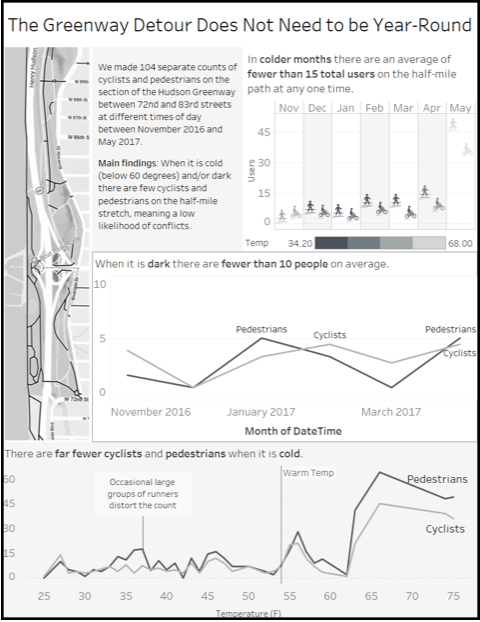A cyclist was injured over the weekend — and the blame can be laid almost entirely on the Parks Department's construction of a hilly, dark and dangerous detour through Riverside Park designed to keep cyclists from the much safer riverfront path. And the injury is reinforcing activists' call to at least allow cyclists to use the safer route during the winter months when there are fewer pedestrians there.
The latest crash happened on Sunday before dark when cyclist Eliana Hecht was tossed from her bike after an off-leash dog darted out in front of her as she descended the hilly detour near the 79th Street traffic circle — an incident she could have entirely avoided had she still been allowed to use the normal flat bike path instead of the inland up-and-down route.
"As a result of what happened to me I now feel that this route is unsafe and that I shouldn't bike on it anymore," the scraped-up Hecht told Streetsblog. "The same thing could happen again."
Hecht and the former chairman of Community Board 7’s Parks and Environment Committee Ken Coughlin were pedaling down the last stretch of the narrow hill when Hecht couldn’t stop in time to avoid the wilding animal — she grazed the dog and crashed, causing minor injuries to her hip, elbow, hand, and face. She also had to cough up $160 for bike repairs, including getting a new front wheel, according to Coughlin.
The dog was fine, Coughlin added, although it legally should not have been off its leash before 9 p.m., according to Parks Department rules. But the real blame is on the inland detour itself; had Hecht been allowed to still use the flat riverside path, she could have stopped in time; plus, the dog would have been more likely to be on its owners leash there than in the more secluded and wooded area, said Coughlin.
“The detour adds a new element of danger that is not present on the waterfront path – gravity. Eliana was simply coasting down a hill. If she had been on the flat waterfront path, she would have been going no faster than 10 mph — likely slow enough to take evasive action or stop before hitting the animal," said Coughlin. “Adding to the mix bikes going far faster than they ever would on the waterfront path is just asking for trouble."

Cyclists have been warning about the dangers of the inland detour for months, ever since the Parks Department hastily created the bypass between 72nd and 83rd streets over the summer out of an abundance of caution to prevent conflict and crashes between cyclists and pedestrians. Some bikers say the detour is more dangerous, especially during the winter months when the poorly lit route is even darker — and now there's proof.
Last week, safe-street group Streetopia UWS sent out the second letter of its kind urging local leaders to reopen the normal path to cyclists since the possibility for crashes between cyclists and pedestrians goes down as the numbers of both users of the Hudson River Greenway are reduced during the colder months, according to data collected by Coughlin between November 2016 and May 2017 (see chart right). Meanwhile, the possibility of a biker hurting themselves or a cyclist on the poorly lit detour is more likely.
“We implore you to consider alternatives to the mandatory detour, especially in these winter months with lower bicycling volumes, lower pedestrian volumes, and cold/dark/wet conditions,” said Lisa Orman, Streetopia UWS’s director in her Nov. 11 letter to the Riverside Park Conservancy.
The Parks Department says the issue of off-leash dogs is not unique to the detour area, but that it is monitoring the route for both pedestrians and cyclists.
"We are looking into concerns raised and will continue to monitor the pedestrian and cyclist experience in Riverside Park," said a Parks Department spokeswoman.






